Kilimoerevu by team GreenForce
Unlocking the Potential of Rainwater harvesting and Wastewater re-use
Welcome to kilimoErevu, a fast-paced startup with the goal of optimizing the process of rainwater harvesting and wastewater reuse targeting households in Kenya and globally.
Rainwater Harvesting
Rainwater is arguably the most accessible and sustainable source of water in the world. Rainwater falls on the roof of the building where it is used, so everyone has access to rainwater without expensive costs. A roof is a non-trafficable surface so there are few opportunities for contamination. Rainwater is simple to manage and treat at a low cost. Rainwater harvesting is most efficient as part of an integrated water management approach with multiple water sources for seasonal water security. Rainwater harvesting at a local scale has a profound impact on stormwater management at the metropolitan level, reducing the volume, peak flow and contaminant levels in stormwater.
According to UN reports rainwater harvesting could end much of Africa’s water shortage. The reports considered Africa as not water scarce. The rainfall contribution is more than adequate to meet the needs of the current population several times over. The report stated that Kenya would not be categorized as a ‘water-stressed country’ if rainwater harvesting is considered. The water crisis in Africa was found to be more of an economic problem from a lack of investment and not a matter of physical scarcity.
What Kenya needs to do to save its population from hunger and water-related problems using its gold in the form of rainfall
According to the 2019 household and population census, there is a total of 12 million conventional households in Kenya. Of these households, 3.9% translates to 469,678 households engaging in rainwater harvesting. To lay out the rural-urban status, 79%(368,964) of these households are rural-based and 21%(100714) are urban-based.
In Kenya, largely due to recurrent droughts, over 3 million families that rely on crops and livestock are threatened and thousands of people die each year as a result of thirst and hunger. With the Kenyan population being projected to grow drastically in the next few decades and climate change being a global issue, clean water provision will be an even greater task.
It is good to note that Kenya receives heavy rainfall annually which is characterised by heavy flooding and landslides. This further leads to the loss of lives and livelihoods.
How do we then mitigate this challenge?
We can only avoid these water challenges by adopting smart ways to manage the rainwater that the country receives so as to ensure that the existing households benefit from it rather than die from it. This team, therefore, proposes a smart approach to rainwater harvesting and wastewater reuse which will have less financial implications for the end-user.
To achieve this, we have developed a platform that provides information and technical know-how on how to implement rainwater harvesting and reuse at the household level. This platform by the name KILIMOEREVU has the following functionalities:
- Provides an overview of the current situation in Kenya in terms of drinking water sources and basic sanitation
- A data entry point that is comprised of the selection of the residential area, entry of the roof area, entry of the size of the water tank, entry of the domestic water use per day in litres and entry of the proposed irrigation area size. There are two ways of selecting the roof area which is either by measuring it manually or using google maps to estimate the roof area and perimeter which are provided in the application.
- A calculator which gives the analysis and results to the user based on the entered data.
- Costing which estimates the tank prices based on the entered volume.
- Contact details where one can reach us at their convenience.
- The platform also has the virmifiltration section which is the proposed method of wastewater filtration and re-use.
The application is as outlined below.
Home page
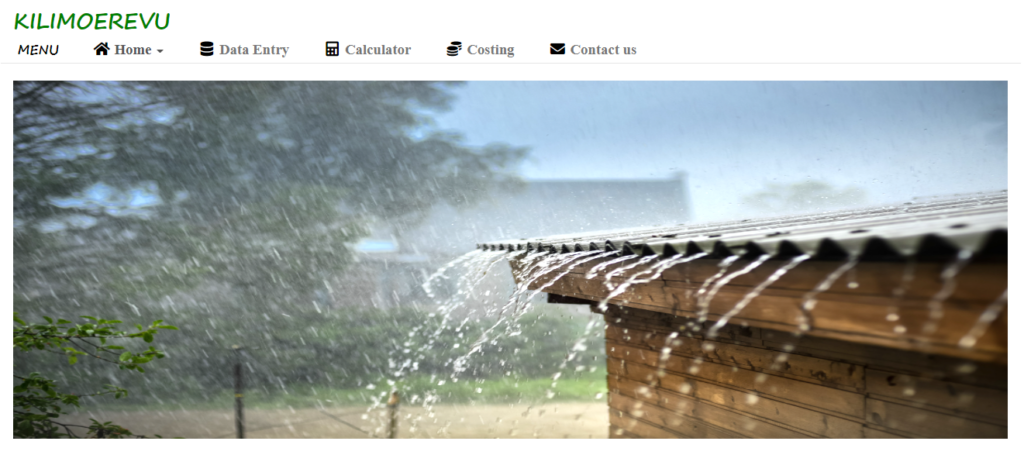
The application home page is as shown in the above image. It contains a navigation bar which leads to the data entry form, the application calculator, the cost estimator and the contact page.
The home page menu also has a dropdown menu which contains the situation maps and the vermifiltration process outline.
Maps
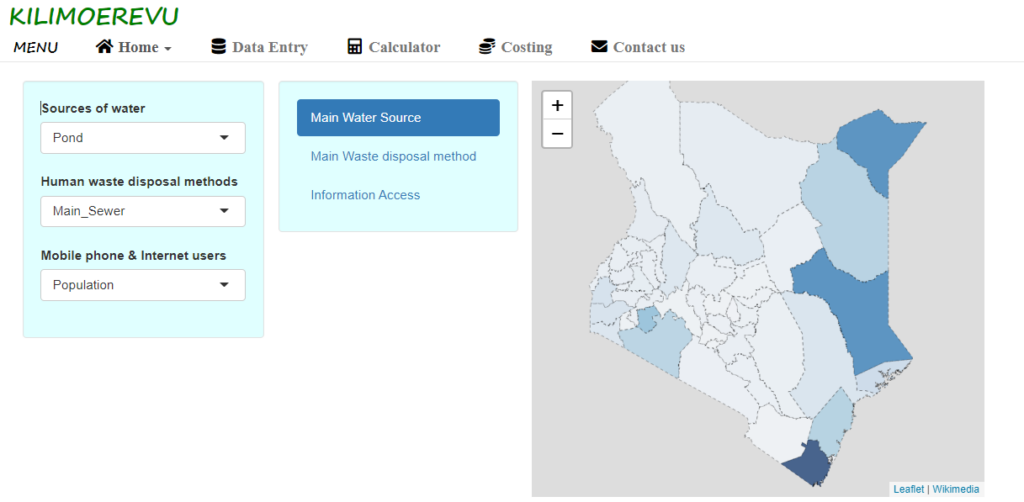
Under this page, the application maps real-life situation datasets based on the following:
- Water sources. Under this one, the tool seeks to check the main sources of water in each region in Kenya. This information helps the viewer to understand the areas facing a crisis and those that practice good water harvesting and management techniques. It also outlines the areas that are struggling with a lack of clean water which is a basic necessity.
- Waste disposal. This is yet another important area that this tool looks into given the fact that poor waste management practices often lead to water and environmental pollution.
- Information access. Under this bracket, this tool looks into how Kenyans access information and in what percentages. It is believed that access to basic information can lead to better decision-making because as they say, “information is power and the secreting or hoarding of knowledge or information may be an act of tyranny camouflaged as humility”
Data entry form
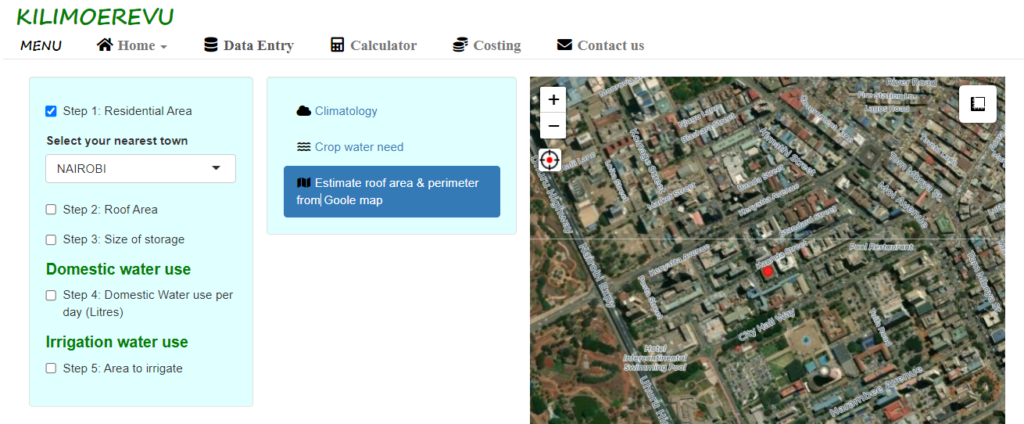
The data entry page contains the following information.
- Data entry form. The data entry form is one of the core parts of this tool. The data sets required under this form are as follows; The residential area/region, roof area (square meters), water storage size (litres), amount of water used in a household per day in litres and the size of irritation land in square meters.
- Climatology. This section displays the historic climate trends for each County in Kenya for the past 30 years.
- Crop water need. This section displays the amount of water required by crops per month in Kenya.
- Google map locator. This section has a map that is used to ease the work of the user. It digitizes the roof based on the user’s location and draws a polygon over the roof and also the irrigation area/field.
Calculator
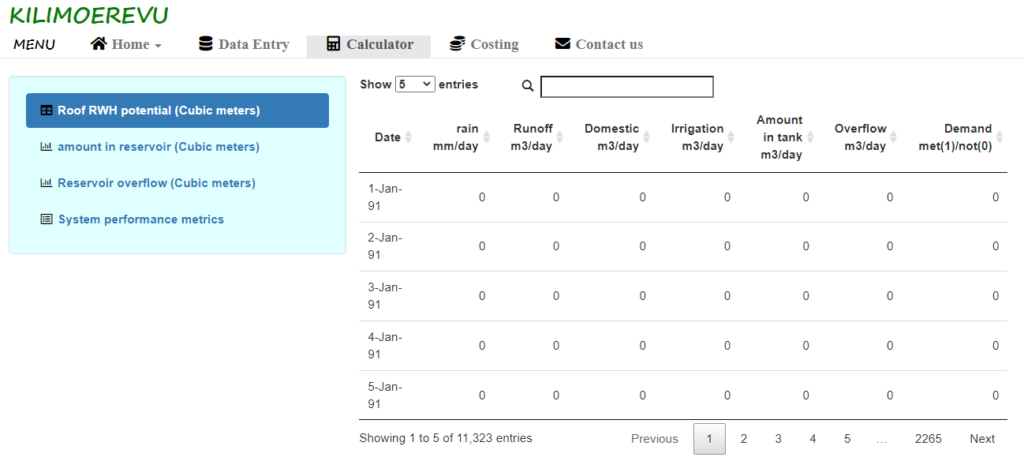
The calculator page contains:
- Roof rainwater harvesting potential. Under this panel, the tool gives a detailed calculation based on the dataset provided by the user on the actual potential of water that his/her roof can actually collect. The tool makes use of rainfall data of the specific area and this data is fetched from Chirps.
- Amount in reservoir. Here, the client is able to monitor his/her water usage and track the amount of the water in storage.
- Reservoir overflow. Here, the client is able to check the amount of water being lost as a result of an overflow.
- Performance metrics. Under this panel, the tool calculates three measures of performance.
The measures are as follows:
- Reliability: Here, the user is able to see how reliable his/her water collection and usage is by recording the fraction that his/her water demand was met. Basically, reliability of 50% is okay.
- Satisfaction: Here, the user is able to see the fraction of demand volume that was met by the system.
- Efficiency: This metric shows the user the fraction of runoff that was actually used based on the water needs.
These metrics are given in percentages.
Costing
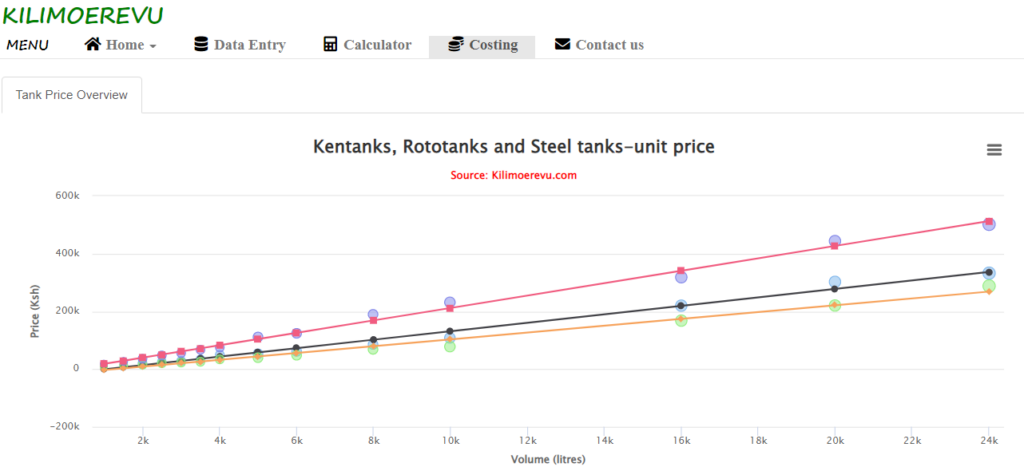
Under costing, this tool estimates the current market prices for different tank and reservoir brands. The tools makes use of a mathematical linear function to fit real tank prices in the market and estimate prices based on the reservoir volume provided by the user during data entry.
The following image shows an example of how this tool calculates the prices. The volume used in this instance is 50,000 litres.
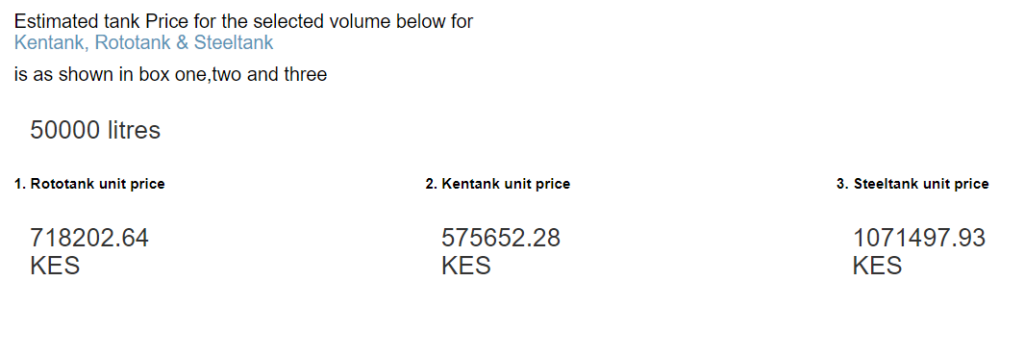
From the above example, it is seen that the tool calculates different prices based on the reservoir brand.
Vermifiltration
Wastewater treatment and reuse is one of the most promising efforts to stem the global water crisis. The main motive of green technology is to provide high-end results without compromising on environmental sustainability. Vermifiltration is an extension of the vermicomposting process. It is a biofilter with earthworms that digest the suspended particles screened on a filter bed and degrade organic matter through enzymatic activity and in the process of ingestion they passively aerate the system by burrowing action and remove pathogens. It results in useful products, treated clear water for reuse purposes and vermicompost which can be used in agricultural fields as organic manure. It is an extension of soil filtration with earthworms to speed up the decomposition process to utilize organics to produce fresh manure. Wastewater passes through the active layer where organic matter is converted into humus-enriched vermicompost by earthworms. Filter media supports the growth of micro-organisms and subsequently, secondary treatment occurs. The grinding activity of earthworms helps in increasing the total surface area present in the filter media, enabling higher absorption of organic and inorganic contaminants from the wastewater. Dissolved and suspended particles are trapped in the filter media as they percolate and are stabilized through complex bioprocesses that take place in the active layer. Dissolved components of wastewater move further down in the profiles absorbed into the surface matrix media and are degraded by the symbiotic action of earthworms released enzymes and microbes. Vermifilter does not clog because earthworms improve aeration by burrowing action and accelerate microbial activity increasing the population of soil micro-organisms thus increasing the utilization of organisms.
This process is as outlined in the image below;
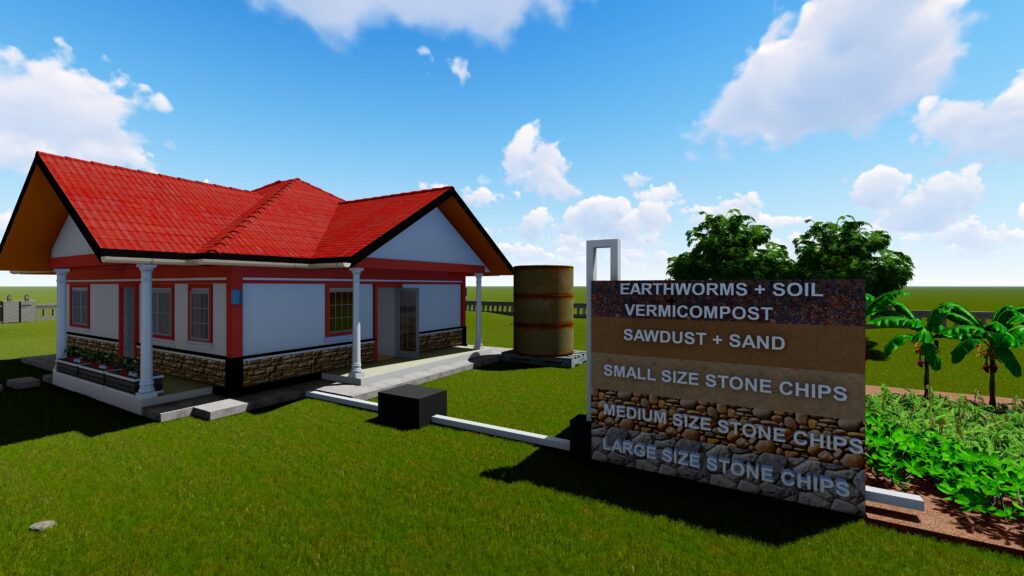
Design parameters
Hydraulic loading rate – it is the application of wastewater to the unit area of the vermibed for unit time.
Hydraulic retention time – it is the time of interaction of wastewater with the filter media in which earthworms reside.
Stocking density – refers to the population of earthworms applied to the bed. Earthworms bigger in size can treat more efficiently compared to smaller ones due to their voracious eating habits. Optimum stocking density lies between 15,000 and 20,000 worms/m3.
Earthworms survive best in the PH range of 6.2 to 9. A temperature of 25-27 degrees Celsius is the optimum range for the activity, growth and reproduction of epigenic earthworm species. Earthworms need a suitable dwelling habitat to thrive upon and perform their activity.
To design the ideal filter media different materials will be utilized such as river bed gravel, stone chips and sand. This filter media also influence the establishment of microbial biofilms and microbial community structure within the complex vermi-ecosystem and treatment performance. The operational and environmental conditions play an important role in the vermifiltration process.
The process of rainwater harvesting and wastewater re-use overview
This video shows the detailed process of rainwater harvesting and its storage and details the process of using the water in the household for activities such as kitchen washing and bathing. It also outlines how the intended wastewater is filtered through virmifiltration, stored and used. It also shows a small smart garden where the purified wastewater is used for the irrigation of crops such as vegetables.
From the video, rainwater is harvested using the roof and stored in a tank. The water is then used in the household for household chores and bathing. The used water is then pumped into the vermicompost tank where vermifiltration is used to clean the water. The cleaned water is then used to irrigate a small kitchen garden.
For the water and wastewater, plumbing inside an existing house will need retrofitting but for new houses, the plumbing should consider harvesting and recycling.
Impact and the way forward into the future
This solution has the potential to not only make households’ water sufficient but also ensure that the households are food secure by eating fresh produce from their gardens as the platform provides information on how irrigation can be done using filtered wastewater. It will also ensure that floods are on a minimal scale and drought and hunger are a thing of the past. Since the virmifiltration process uses compost to produce worms used in the process, households will benefit better as they will use the compost waste they produce in the process hence leading to a positive reduction of environmental pollution. The value of sustainability has increased drastically in the last decades and our solution can provide a direct contribution to 3 out of the 17 UN sustainable development goals namely:
- Clean water and Sanitation
- Climate Action and
- Zero hunger
Going into the future, we would like to market the KilimoErevu application to businesses dealing with rainwater tanks and irrigation. We are also open to advertising different businesses that deal with rainwater harvesting, wastewater reuse and irrigation.





